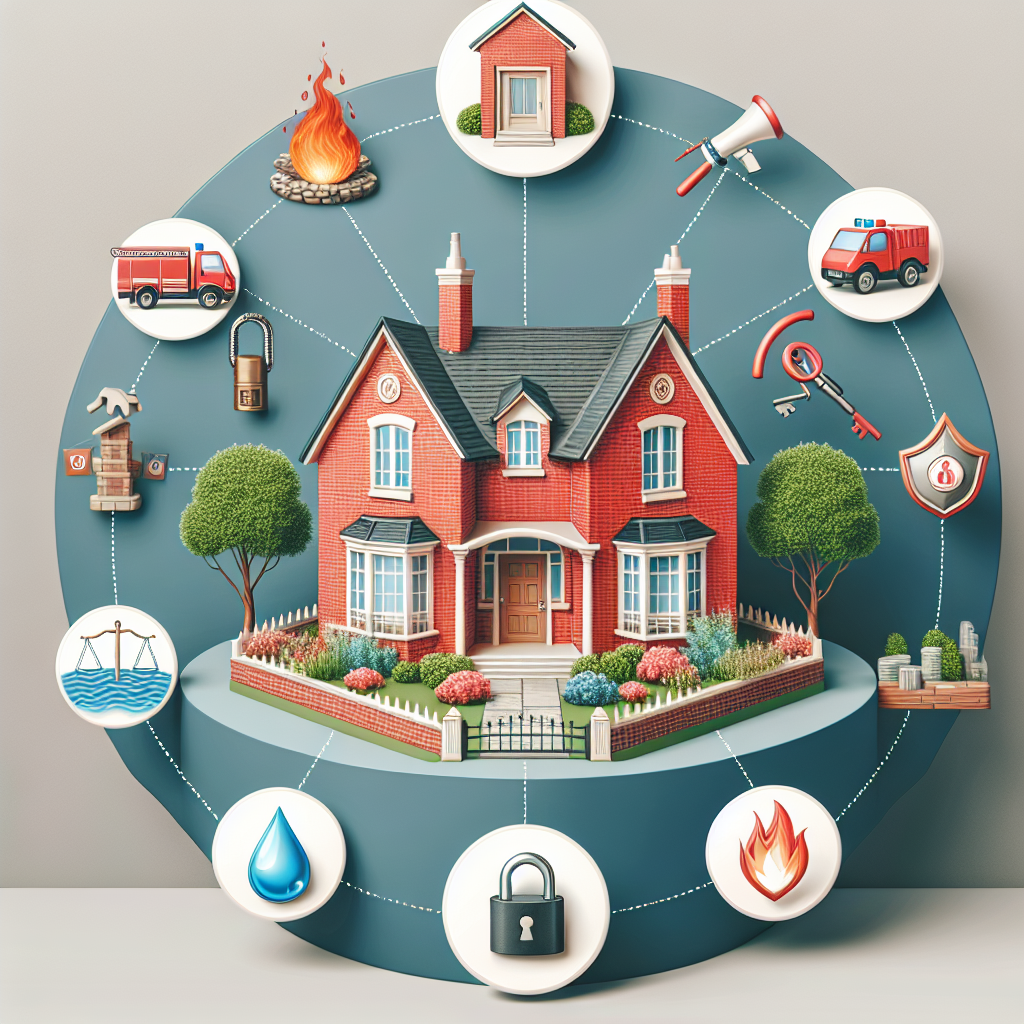Filed under Home Insurance on
Extra Coverage Home Insurance: What You Need to Know

If you’re wondering whether your standard homeowners policy truly protects the life you’ve built, you’re not alone. Weather extremes, rising rebuild costs, and changing lifestyles have all exposed gaps in basic policies. That’s where Extra Coverage Home Insurance comes in—an intentional mix of endorsements and specialty policies that closes the financial cracks before they become costly claims. This guide breaks down the essentials, translates jargon into plain language, and helps you decide which add-ons are worth it for your home and budget.
What “extra coverage” really means
Despite how it sounds, Extra Coverage Home Insurance is not a single plan. It’s a strategy. In practice, it combines targeted endorsements (also called riders) with separate policies for specific risks your base policy doesn’t cover well—or at all. Think jewelry schedules, water backup coverage, equipment breakdown, flood or earthquake policies, and personal umbrella liability.
For most households, the goal is simple: align coverage with real-world risks and replace guesswork with a plan. Done right, this approach helps you avoid surprise exclusions, outdated limits, and claim-time disappointments.
Why you might need more than a standard policy
Home insurance has a strong foundation, but it’s designed for the median homeowner, not your specific situation. Several trends make tailored protection crucial today:
- Construction inflation: Rebuild costs for materials and labor have climbed sharply in recent years, outpacing many policy limits.
- Climate volatility: Heavier rain, wind, and wildfire seasons are triggering more losses, and some perils require separate coverage.
- Lifestyle shifts: Remote work, home-based businesses, and short-term rentals often fall outside standard protection.
- High-value belongings: Jewelry, art, collectibles, and specialty gear frequently exceed sublimits in a basic policy.
- Liability exposure: Pools, trampolines, dogs, and teen drivers increase the odds—and cost—of lawsuits.
Extra Coverage Home Insurance gives you the flexibility to address the risks you actually face, not just those your neighbors do.
What standard home insurance covers—and where it stops
Most U.S. homeowners carry an HO-3 policy. It usually provides:
- Dwelling: “Open perils” coverage for your home’s structure (unless excluded).
- Personal property: “Named perils” coverage for your belongings (fire, theft, etc.).
- Liability: Protection if you’re found legally responsible for injuries or property damage.
- Additional living expenses: Helps with temporary housing if a covered loss makes your home uninhabitable.
Limits, deductibles, and exclusions define your real coverage. Common gaps include:
- Sublimits on valuables: Jewelry theft might cap at $1,500; cash at $200; collectibles, firearms, and silverware also have low limits.
- Water backup: Sewer, drain, or sump pump backup isn’t usually covered without an endorsement.
- Earthquake and flood: Typically excluded; require separate policies.
- Building code upgrades: “Ordinance or law” costs to bring repairs up to current codes are limited or excluded without extra coverage.
- Depreciation on some roofs: In many markets, older roofs settle at actual cash value (ACV) instead of replacement cost (RCV) unless adjusted.
- Business property: Equipment and inventory at home often have very low limits.
Knowing where the standard policy stops is the first step toward choosing smart add-ons.
Popular add-ons and how they protect you
Scheduled personal property
Scheduling jewelry, watches, fine art, instruments, or collectibles lets you insure specific items for their appraised value. Benefits often include broader causes of loss (including mysterious disappearance), no deductible, and worldwide coverage. If you own a $12,000 engagement ring, scheduling it is typically far cheaper than learning your theft sublimit is $1,500 after a loss.
Water backup and sump overflow
This endorsement covers damage from water backing up through sewers, drains, or sump systems—events that can devastate basements and first floors. Limits are typically selected (e.g., $5,000–$50,000). If your home sits below grade, this is one of the most cost-effective riders available.
Service line coverage
Homeowners are often surprised to learn they’re responsible for underground utility lines on their property—water, sewer, electrical, and more. Service line coverage pays to repair or replace them if they fail due to wear and tear, root intrusion, or freeze—situations standard policies exclude.
Equipment breakdown
Think of it as a mini “home systems warranty” within your policy. It covers sudden mechanical or electrical breakdown of central air, boilers, appliances, and smart home systems, often including surge damage. It’s not a maintenance plan, but it can be a lifesaver for big-ticket systems.
Ordinance or law (code upgrade) coverage
When you rebuild after a covered loss, you must meet current building codes—and upgrades can be pricey. Without this endorsement, you pay the difference out of pocket. Consider 25%–50% of your dwelling limit in older homes or areas with strict codes.
Extended or guaranteed replacement cost
Extended replacement cost increases your dwelling limit by a set percentage (often 25%–50%) if a total loss exceeds your stated coverage. Guaranteed replacement cost goes further, paying to rebuild your home as it was, even if costs exceed the limit. With construction inflation and regional labor shortages, either option can be the difference between a full rebuild and a financial shortfall.
Inflation guard
This feature adjusts your dwelling limit throughout the year to keep pace with construction cost trends. It’s not a cure-all, but it helps reduce underinsurance risk.
Matching of undamaged materials
If a portion of your siding or flooring is damaged, replacement materials may not match the rest. Some policies only replace the damaged area, leaving a patchwork effect. A “matching” endorsement helps ensure a uniform look, which matters for curb appeal and resale value.
Loss assessment (for condos)
Condo owners can be charged by their HOA for deductibles or shared losses (like a windstorm roof claim). Loss assessment coverage helps pay your share, within limits, when the master policy falls short.
Short-term rental endorsement
Occasional Airbnb-style hosting often isn’t covered under a standard homeowner policy. A host or home-sharing endorsement—sometimes a separate policy—can address guest-caused damage, liability, and loss of income between bookings.
Identity theft and personal cyber
Identity restoration, cyberbullying liability, and coverage for cyber fraud or data breaches at home are increasingly common add-ons. If your household relies on smart devices or remote work, ask how these apply.
Disaster-specific protection
Some hazards require separate policies or highly specific endorsements. If you live in a region with elevated risk, these may be essential elements of your Extra Coverage Home Insurance strategy.
- Flood insurance: Standard homeowners policies exclude flood. Federal (NFIP) and private flood options exist; private policies may offer higher limits and additional coverages.
- Earthquake insurance: Typically a separate policy with higher deductibles (often 10%–25% of dwelling limit). Brace water heaters, secure foundations, and retrofit to improve insurability.
- Wind, hail, and named storm deductibles: Coastal and hail-prone areas often carry percentage deductibles for wind events. Understand whether the deductible applies by wind speed, storm naming, or hurricane declaration.
- Wildfire risk: Insurers increasingly require defensible space, Class A roofing, ember-resistant vents, and community mitigation. Some carriers offer wildfire response services as an endorsement.
- Freeze and power outage: Verify coverage for frozen pipes and food spoilage, especially in areas with grid instability.
Liability protection beyond the basics
Liability is where claims can climb rapidly. Medical bills, lost wages, legal defense, and settlements stack up fast. Consider these layers:
- Higher liability limits on your home policy: Many carriers allow $500,000–$1,000,000.
- Personal umbrella policy: Adds $1–$5 million (or more) above your home and auto liability limits. It’s typically affordable and crucial if you have significant assets or future income to protect.
- Personal injury endorsement: Covers libel, slander, and invasion of privacy—important in the era of social media.
- Risk red flags: Pools, trampolines, certain dog breeds, and rental activities may need special underwriting or exclusions. Confirm before a claim tests the fine print.
What it costs—and how to keep it affordable
Premiums vary by state, home characteristics, claims history, and insurer. As a broad guide, national homeowners premiums in recent years have commonly ranged around the low-to-mid thousands annually, with disaster-prone states markedly higher. Layering Extra Coverage Home Insurance typically adds manageable increments:
- Scheduled jewelry/art: Roughly 1%–2% of appraised value per year, often less for vault-stored items.
- Water backup: From a modest annual add-on for lower limits to a few hundred dollars for higher limits.
- Service line: Typically inexpensive, often under a few dollars per month.
- Equipment breakdown: Usually modest, often under $100 per year.
- Ordinance or law: Cost scales with the percentage selected (e.g., 25% vs. 50%).
- Flood/earthquake: Highly location-dependent; shop both NFIP and private markets where available.
- Personal umbrella: Commonly a few hundred dollars per million in coverage, with variations by risk profile.
Ways to manage cost without compromising protection:
- Bundle home and auto for multi-policy discounts.
- Increase your base deductible to fund critical endorsements.
- Install mitigation: leak sensors, monitored alarms, automatic water shutoff, impact-resistant roofing, and wildfire hardening improvements.
- Review and update coverage annually; inflation guard helps, but it isn’t a set-and-forget solution.
- Ask about claims-free and loyalty discounts, and verify eligibility after updates.
How to build the right mix for your home
- Estimate true rebuild cost: Use your insurer’s replacement cost estimator and sanity-check with a local contractor. Include outbuildings, custom finishes, and site access challenges.
- Inventory your belongings: A quick video walk-through plus a spreadsheet of high-value items and appraisals will do.
- Map your risks: Flood zone, fault lines, wildfire interface, hail and wind history, sewer line age, and roof condition all matter.
- Read the fine print: Focus on exclusions, sublimits, roof settlement (ACV vs. RCV), and special deductibles.
- Add targeted endorsements: Prioritize water backup, ordinance or law, and scheduled property if applicable; consider service line and equipment breakdown for broad resilience.
- Choose sensible deductibles: Opt for a higher base deductible to afford must-have add-ons; understand percentage deductibles for wind or quake.
- Layer liability: Raise base limits and add a personal umbrella if your assets or income warrant it.
- Re-evaluate yearly: Update schedules, adjust limits for renovations, and remove coverages you no longer need.
Market trends to watch
The property insurance landscape is shifting quickly, and these trends affect availability, price, and terms:
- Reinsurance costs: Global reinsurers have raised prices after years of heavy catastrophe losses, pushing premiums up for homeowners.
- Carrier pullbacks: Some insurers have paused new business or non-renewed high-risk properties in wildfire and hurricane corridors.
- Roof scrutiny: Expect stricter underwriting on roof age, materials, condition, and hail ratings; ACV settlements are more common for older roofs.
- Data-driven underwriting: Aerial imagery, property analytics, and water-leak sensors influence pricing and eligibility.
- Parametric options: These pay a preset amount when an event threshold is met (e.g., quake magnitude), delivering fast cash for immediate needs, sometimes alongside traditional coverage.
- Mitigation incentives: Carriers and states are expanding discounts and grants for home hardening and storm resilience.
In this environment, Extra Coverage Home Insurance isn’t just a luxury—it’s a way to stay insurable on favorable terms.
Claims-proof your policy before a loss
Good coverage is only half the battle; documentation and preparation make claims smoother and faster:
- Keep receipts and appraisals for scheduled items; update them every 2–3 years.
- Photograph rooms and serial numbers; store backups offsite or in the cloud.
- Install leak detection and smart shutoff valves; insurers increasingly reward this.
- Review contractor estimates for “like kind and quality” and insist on code upgrades if you carry ordinance or law coverage.
- Track additional living expenses during displacement; keep itemized logs and receipts.
- Ask your agent about claim-preferred vendors, but remember you can choose your own licensed contractor.
- For major losses, consult a trusted contractor or a public adjuster if you need help interpreting the estimate.
Common mistakes that cost homeowners
- Underinsuring the dwelling: Skimping on limits risks a partial payout that won’t rebuild your home.
- Skipping code coverage: Repairs that don’t meet current codes can stall permits and drain savings.
- Ignoring water risks: Water backup is among the most frequent and expensive claim types—and easily endorsed.
- Not scheduling valuables: Relying on low sublimits for high-value items invites a financial shortfall.
- Wrong deductible mix: High wind or quake deductibles can make claims impractical; balance affordability and usability.
- Overlooking liability: A single lawsuit can exceed home policy limits; umbrellas are inexpensive relative to protection.
- Assuming flood is included: It isn’t. Even moderate rain events can trigger unexpected flood damage.
Expert insights and practical examples
Insurance associations and catastrophe modelers have noted a steady rise in weather-related losses over the past decade, with secondary perils—hail, convective storms, and wildfire—driving much of the volatility. Builders report that materials and labor costs remain elevated compared to pre-2020 baselines. Together, these forces mean small coverage gaps can quickly become five- or six-figure out-of-pocket expenses.
Practical scenarios show why tailored add-ons matter:
- A basement family room ruined by a sump pump failure: Without water backup coverage, the loss may be denied despite being “water-related.”
- A hailstorm destroys a 15-year-old roof: Some policies pay ACV due to age, leaving you to fund the depreciation unless your policy provides RCV on roofs.
- Kitchen fire reveals outdated wiring: Code upgrade coverage funds the necessary rewire so you can pass inspection and restore safely.
- A lost diamond earring at a hotel: Scheduled coverage treats “mysterious disappearance” as covered, avoiding a denial under standard named perils.
FAQs
Is Extra Coverage Home Insurance only for luxury homes?
No. It’s about tailoring, not extravagance. A modest home might need water backup, service line, and a small jewelry schedule. A larger home might focus on extended replacement cost and umbrella liability. The right mix fits your risks, not your square footage.
How often should I review my policy?
Annually at minimum, and after any renovation, major purchase, or change in use (like starting a home business or short-term renting). Update appraisals and schedules every few years.
What’s the difference between replacement cost and actual cash value?
Replacement cost pays to rebuild or replace without deducting for depreciation. Actual cash value subtracts depreciation, often resulting in lower payouts. For roofs and personal property, RCV generally offers stronger protection.
Do smart home devices really lower premiums?
Often, yes—especially monitored alarms, water leak sensors with automatic shutoff, and wildfire or wind mitigation upgrades. Discounts vary by carrier and state.
Will claims raise my rates?
They can. Frequency and severity matter. Maintaining a claims-free record, choosing higher deductibles judiciously, and using Extra Coverage Home Insurance to prevent large losses helps keep premiums stable over time.
Is flood coverage necessary outside high-risk zones?
Roughly a quarter of flood claims historically come from outside high-risk zones. If heavy rain and drainage issues are common where you live, consider a flood policy even if your mortgage doesn’t require it.
Quick checklist: building your protection plan
- Confirm accurate dwelling replacement cost; add extended or guaranteed replacement if available.
- Enable inflation guard and verify roof settlement terms (RCV vs. ACV).
- Schedule jewelry, art, instruments, or collectibles above sublimits.
- Add water backup, service line, and equipment breakdown for everyday resilience.
- Secure ordinance or law coverage at 25%–50% for older or heavily regulated areas.
- Evaluate flood, earthquake, and wind deductibles based on regional hazards.
- Lift liability to $500,000–$1,000,000 and add an umbrella if your assets or income justify it.
- Document your home and belongings; store records offsite.
- Install leak sensors, monitored security, and mitigation features to earn credits.
Putting it all together
Standard homeowners insurance still does heavy lifting, but today’s risks and rebuild economics mean the basics often aren’t enough by themselves. The smartest approach is proactive: identify your exposures, prioritize the biggest financial threats, and layer targeted solutions. In other words, treat Extra Coverage Home Insurance as a toolkit—one that scales with your life changes, protects your long-term finances, and helps you recover fully after a loss.
Start by reviewing your current declarations page, listing valuables and home systems, and asking your agent about water backup, code upgrades, service line, and scheduled property. From there, consider disaster-specific policies and umbrella liability. With a thoughtful plan, you can transform a generic policy into a resilient safety net—one that matches the home and future you’re working so hard to build.
Above all, revisit the plan annually. As prices, weather, and life evolve, so should your coverage. Extra Coverage Home Insurance isn’t a one-time purchase—it’s an ongoing strategy that keeps your protection as dynamic as the world around you.





